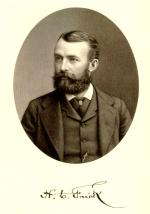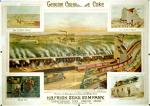![header=[Marker Text] body=[Pittsburgh industrialist and philanthropist, Frick was instrumental in the organization of the coke and steel industries. His controversial management style while chairman of Carnegie Steel led to the bloody Homestead Strike, 1892.] sign](http://explorepahistory.com/kora/files/1/10/1-A-237-139-ExplorePAHistory-a0h6s2-a_450.jpg)
Mouse over for marker text
Name:
Henry Clay Frick [Pgh office]
Region:
Pittsburgh Region
County:
Allegheny
Marker Location:
437 Grant St., Frick Bldg., Pittsburgh
Dedication Date:
December 10, 1946
Behind the Marker
This reporter from the Pittsburgh Dispatch had the truth down cold. By 1902, when the Frick Building opened its doors to tenants, relations between Henry Clay Frick and Andrew Carnegie had turned to ice. Just two years earlier, Frick had been humiliated by his ejection from the Carnegie realm.
Andrew Carnegie had turned to ice. Just two years earlier, Frick had been humiliated by his ejection from the Carnegie realm.
With the soaring twenty-story Frick Building, its gleaming white granite exterior, and beautiful lobby replete with a La Farge stained glass window (depicting the figure of Fortune and her wheel), Frick made a forceful statement. Certainly, his new building pushed Carnegie's fifteen-story skyscraper, the city's first, into the second tier. Later, in New York, Frick spent $5.4 million on building an opulent mansion in Manhattan (now the Frick Collection), reportedly to "make Carnegie's place look like a miner's shack."
Bad blood had existed between Frick and Carnegie for many years. Frick had entered the Connellsville coke industry in the 1870s, and quickly became its leading figure. His relentless search for capital to pay for more coal lands and more
leading figure. His relentless search for capital to pay for more coal lands and more  coke ovens brought him to the attention of Andrew Carnegie.
coke ovens brought him to the attention of Andrew Carnegie.
Quite literally, Frick's coke fueled Carnegie's fortune in steel. In the early 1880s Carnegie and his partners took a small share in his coke company; after injecting substantial capital for expansion, they soon owned a controlling three-fourths share. In midst of a strike in 1887, they forced Frick to grant his coke workers a substantial pay raise to keep the coke flowing to the steel mills. Frick never forgave the insult.
Coal and coke were not the only valuable assets Frick brought to the Carnegie steelmaking enterprise. In his Autobiography, Carnegie recalled that Frick's company possessed not only valuable coal and coke but in Frick himself "a positive genius for its management." Fellow Carnegie executive Charles Schwab recalled Frick as "the most methodical thinking machine I have ever known." Frick was in the top ranks of decision-making at Carnegie Steel, serving as president or chairman from 1889 until 1900, during the very years the enterprise became the world's largest steelmaker.
Charles Schwab recalled Frick as "the most methodical thinking machine I have ever known." Frick was in the top ranks of decision-making at Carnegie Steel, serving as president or chairman from 1889 until 1900, during the very years the enterprise became the world's largest steelmaker.
Frick's "controversial managerial style" was a blend of relentless drive for efficiency, blunt honesty, and utter disdain for workers. In 1891, at the Morewood Massacre near Mt. Pleasant, his deputies fired into a marching column of striking coke workers killing seven of them. With the
Morewood Massacre near Mt. Pleasant, his deputies fired into a marching column of striking coke workers killing seven of them. With the  Homestead strike of 1892, Frick gained national notoriety for provoking a deadly shootout with the strikers.
Homestead strike of 1892, Frick gained national notoriety for provoking a deadly shootout with the strikers.
Though less well known, the real success of Carnegie Steel came in the wake of the Homestead crisis. The company broke the union, built up the Duquesne steel works and the Carrie iron furnaces, and created a coordinated business empire. It invested the massive profits from selling battleship armor in choice tracks of Minnesota iron ore lands. Finally, it battled the Pennsylvania Railroad for favorable rates and even built two railroads of its own. When J.P. Morgan formed U.S. Steel in 1901, the Carnegie Steel enterprise was its showpiece.
Duquesne steel works and the Carrie iron furnaces, and created a coordinated business empire. It invested the massive profits from selling battleship armor in choice tracks of Minnesota iron ore lands. Finally, it battled the Pennsylvania Railroad for favorable rates and even built two railroads of its own. When J.P. Morgan formed U.S. Steel in 1901, the Carnegie Steel enterprise was its showpiece.
Frick remained a hard man through his death in December 1919, just four months after Carnegie himself died. In his later days, feeling generous as always, Carnegie sent him a note suggesting they meet and forget past battles. "Tell Mr. Carnegie," Frick answered, "I'll meet him in Hell."
"The personal relations between Carnegie and Frick took on a somewhat puerile phase, but not without the expenditure of millions. To build a 15 story building and then to have your former chum build a 20 story building to shut out its light is not much different from the temper displayed when one boy, building a sand mound, finds that his former chum is undermining it to build another beside it."-Pittsburgh Dispatch, April 7, 1900.
This reporter from the Pittsburgh Dispatch had the truth down cold. By 1902, when the Frick Building opened its doors to tenants, relations between Henry Clay Frick and
With the soaring twenty-story Frick Building, its gleaming white granite exterior, and beautiful lobby replete with a La Farge stained glass window (depicting the figure of Fortune and her wheel), Frick made a forceful statement. Certainly, his new building pushed Carnegie's fifteen-story skyscraper, the city's first, into the second tier. Later, in New York, Frick spent $5.4 million on building an opulent mansion in Manhattan (now the Frick Collection), reportedly to "make Carnegie's place look like a miner's shack."
Bad blood had existed between Frick and Carnegie for many years. Frick had entered the Connellsville coke industry in the 1870s, and quickly became its
Quite literally, Frick's coke fueled Carnegie's fortune in steel. In the early 1880s Carnegie and his partners took a small share in his coke company; after injecting substantial capital for expansion, they soon owned a controlling three-fourths share. In midst of a strike in 1887, they forced Frick to grant his coke workers a substantial pay raise to keep the coke flowing to the steel mills. Frick never forgave the insult.
Coal and coke were not the only valuable assets Frick brought to the Carnegie steelmaking enterprise. In his Autobiography, Carnegie recalled that Frick's company possessed not only valuable coal and coke but in Frick himself "a positive genius for its management." Fellow Carnegie executive
Frick's "controversial managerial style" was a blend of relentless drive for efficiency, blunt honesty, and utter disdain for workers. In 1891, at the
Though less well known, the real success of Carnegie Steel came in the wake of the Homestead crisis. The company broke the union, built up the
Frick remained a hard man through his death in December 1919, just four months after Carnegie himself died. In his later days, feeling generous as always, Carnegie sent him a note suggesting they meet and forget past battles. "Tell Mr. Carnegie," Frick answered, "I'll meet him in Hell."
Beyond the Marker









